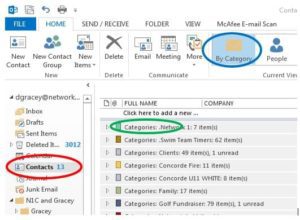By David Gracey
There are few computer applications that have been as widely used as Microsoft’s Outlook. Twenty years ago, Microsoft made the smart business decision to bundle in Outlook with Word and Excel in the Office suite. Back then, there were several different email programs and over the years, Microsoft’s market share led most companies to choose Outlook as their standard. Consumers began migrating to the program as well. For better or worse, just about every Windows desktop and laptop in the world runs one version or another of the email application today. Business or consumer, it’s universal. Even Mac users in recent years have begun using an Apple-friendly version of Outlook.
So when my mother-in-law, Cynthia, described to me how long it took her to type in the 47 email addresses of her bridge club members, I took notice. Cynthia was promoted to be the official score-keeper of her bridge club. Among other responsibilities, this includes uploading the weekly bridge scores, making sure the members have all of their online information entered correctly and generally keeping the “system running.” I’m not sure what that last one means but alarms started sounding inside my head when it began to dawn on me that Cynthia was now the IT person for the bridge club. Yikes! But I knew, with some help, she was ready for the challenge.
After some meditation and talk therapy, I was able to focus on the task at hand: how could we simplify Cynthia’s life to make email communication run more efficiently? My initial response was to introduce Cynthia to the world of Outlook Categories. She has made tremendous strides in working with her laptop so I felt confident she was ready to take the plunge. So we scheduled a time that worked for both of us: she was going to drop off some fresh peaches and corn at our house she had purchased from the road side farmers market on the way back to Atlanta from North Carolina. This was the perfect opportunity. I called her ahead of time to prepare her for what was to come.
My initial task was to understand how she needed to organize her contacts: she had two different bridge clubs and some people were in both. My plans were drawn:
Create Contacts: the initial step was to create a Contact for each person to whom she would be sending emails. Although she had emailed all the individuals at some point, the emails were simply stored in her autofill instead of being a contact. Outlook remembers every email address you send in the autofill section of the TO field, which is “autofill.” I walked her through entering the name and email address for each new contact.
Create Categories: once the contacts were created, we create a category for each of her two bridge groups. From the Outlook Home menu, click CATEGORIZE button then ALL CATEGORIES. From the window (see below) click NEW button. Enter the name of the category you want to create, such as NC Bridge Club.
Assign Contacts to Categories. Once you have the contacts and categories created, simply select the categories for each contact. Open a contact, then click CATEGORIZE drop down and click the category (NC Bridge, for example). Save and Close. Repeat this process for each contact in the group.
Email a group: Click the CONTACTS folder in Outlook (red circle). To view the contacts by category, locate the BY CATEGORY button (blue circle; depends on which version of Outlook you use) and then right click the top level of category bands and choose COLLAPSE ALL CATEGORIES.
Click the category band (green circle) which will highlight the category, then click the EMAIL button at the top of the screen. This will bring up a new email with the TO field populated with all the email addresses. Type your email subject and body, then send it. No more manually typing all those email addresses. (Note: if you’ve entered an incorrect email address in any contact, you’ll see an error message.)








